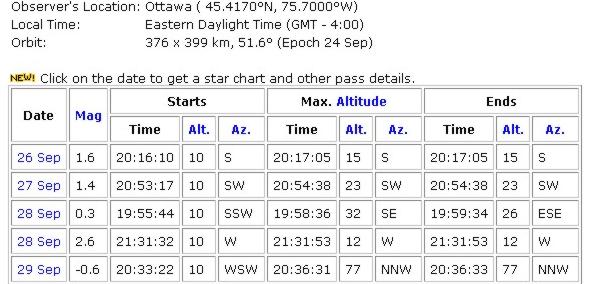

Even though it is a small object at a considerable distance, the ISS sometimes becomes visible to observers on earth.
The ISS orbits the earth every 92 minutes at an average altitude of 380 km. If you know where and when to look, it is actually possible to see this space vehicle when the sun reflects off of it against a dark sky. The ISS looks like a bright star moving quickly, it is usually visible for between 2 and 5 minutes. This phenomenon occurs most frequently shortly after sunset or just before sunrise.
Chris Peat runs a site dedicated to tracking visible space objects - http://www.heavens-above.com
The data from this site comes in a table like the following:

This sample table gives the following information for a pass on September 26, 2002
Date: 26 Sep
Mag: 1.6 - This Magnitude number indicates the maximum brightness of the ISS during this pass. Astronomers use these numbers to indicate the brightness of stars. Smaller numbers indicate brighter objects. The stars in the big dipper have a magnitude of 2, very bright stars have a magnitude of 1 and extremely bright stars have a magnitude of 0 or -1. On September 29 the table indicates that the ISS will be extremely bright with a magnitude of -0.6.
Starts - Time: This is the time that the ISS becomes visible
over the horizon. (20:16:10) - (8:16:10 PM)
Starts - Alt.: This is the altitude of the ISS in degrees above
the horizon at the start time. (10)
Starts - Az.: This is the Azimuth (Compass direction)
where the ISS will appear. N - North, E - East, S - South, W - West
The center part of the table (Max. Altitude) gives the time, altitude and azimuth when the ISS is at maximum altitude.
The last part of the table ( Ends ) gives the time, altitude and azimuth at the end of the pass
Page created by Wayne Campbell